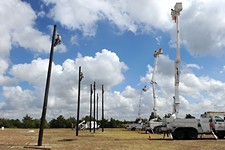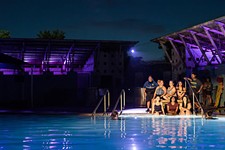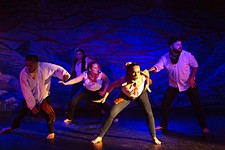Saying "Yes" and "No" with DanceAbility
Body Shift brings Alito Alessi's mixed-ability movement workshops to Austin
By Jonelle Seitz, Fri., Dec. 4, 2015
In the soft daylight filtering through the big, old arched windows of the Anna Hiss Gym at the University of Texas, Alito Alessi is teaching a "yes/no" exercise to a group of 26 dancers, bodyworkers, performers, and teachers. In the exercise, one person initiates an action by gently making contact with his or her partner, who can either give way or resist.
Alessi, a compact figure in maroon sweats and woolly socks, and with shoulder-length hair in a low ponytail, leans into a female participant, who demonstrates how an ever-so-slight yield means yes, agreement, "we."
In this exercise, he says, "There are no maybes." Alessi, the founder of DanceAbility International, an organization that promotes mixed-ability movement improvisation through performance and teaching, came to inclusive work from contemporary dance, but the seeds of mixed-ability work were planted early in his life, when he witnessed the marginalization of disabled members of his family. In DanceAbility, Alessi's method, everyone, regardless of physical or cognitive ability, is given a choice and has a responsibility to make one. Alessi speaks of analyzing any group to determine the "common denominators," which might be sensing, feeling, understanding – or breath, pulse, metabolism.
Alessi taught the yes/no exercise last May, halfway through the two weeks he spent teaching DanceAbility to teachers-in-training from Austin, elsewhere in Texas, Philadelphia, Berkeley, and Mexico. They reconvene this month for two more weeks of instruction that will culminate in certification to teach their own DanceAbility classes. The workshops are coordinated by Body Shift, an organizational collaboration between Forklift Danceworks and VSA Texas that has held mixed-ability classes and performances in Austin for years. Body Shift will continue to host a local monthly class using the DanceAbility method, taught by some of the workshop participants. But others plan to adapt the philosophies of the method to other types of work – say, improv comedy or Argentine tango.
The training workshops are equal parts practice and discussion: Four times each day, the group convenes in a circle to reflect and talk. "It has a tendency to turn into therapy," says Body Shift program coordinator Olivia Whitmer, as when one participant, a hospice worker seated on an exercise ball, disclosed her hesitation about performing (the group will present an "informance" street parade Dec. 18). But when that happens, group members listen to each other and to Alessi with openness and respond with care. Daily schedules are handwritten on large pieces of paper and taped on a mirror. The work is slow. It's Friday of the first week, and they've only just started working with light touch.
"I can dance with a 'no,'" continues Alessi. "What I can never do is overpower that 'no.' If that ever happens, you scream." He takes a sip of tea from a mason jar.
There are questions and answers about logistics: How do you gauge resistance from people with different reaction times and muscle strengths, or who use a manual wheelchair or a power chair that tilts and spins? Alessi gently touches the knees of an improv comedian who, temporarily disabled by an ankle injury, is seated in a borrowed manual wheelchair. "If they don't have brakes, that's how sensitive you need to be. Even before the chair starts to move, I feel the resistance. 'No,' actually, is just in a contraction."
He moves to participant Amy Litzinger, who uses a power chair, and performs an experiment. "If she can't feel her legs – let's see if Amy can say 'no.'" He touches her knees. "Yeah, it only needs to be an impulse. I could feel that impulse."
The participants turn their attention to their partners and try the exercise themselves. Alessi asks the group a rhetorical question: "How well can you know someone just by touching their skin? Everything, actually." Next, he explains, they will complicate the yes/no exercise by alternating roles. He demonstrates with Litzinger:
"I'll begin the yeses."
"I have to make myself accessible to her."
"So are you the leader now?"
"Now I'm the 'no.' Now I'm the 'yes.'"
Alessi places his head under her chin, as though fitting one puzzle piece into another. She allows her head to be tilted back a bit before Alessi feels resistance: "That was a 'no.' Now she's the leader." Soon, each pair is not just doing an exercise but using the strategy to improvise a duet. Alessi calls out gentle prompts and reminders: "This person, this moment, what dancing is to you." "If you change your chair, you will have more options." "If you're confused, just stop rather than continuing, not knowing." No one stops. "Compose the end."
In the discussion circle afterward, which is transcribed for hearing-impaired participants, the comedian with the bum ankle says he is sorry for his absence during the first part of the day, which he feels has caused his "off vibe." A Body Shift teacher, near tears, thanks the group for welcoming her as well as her 5-month-old baby. Litzinger reflects on how the workshop environment facilitates choice. Outside, she says, "I feel like I don't have the ability to say 'no,' so it's just easier to say 'yes.'"
But, Alessi maintains, it is her responsibility to say "no." "We've created the space for you to say 'no.'"
Amy doesn't disagree. "But," she says, "that doesn't always happen in real life."
Four DanceAbility classes, taught by teacher trainees with guidance from Alito Alessi, will be open to the public: Dec. 10–11, 10am–noon and 2:30–4:30pm, at Anna Hiss Gym at the University of Texas. A DanceAbility "informance" street parade will take place Fri., Dec. 18, 4–5:30pm, beginning at the Wells Fargo Bank Plaza at Second & Congress, and ending in front of City Hall. For more information, visit www.bodyshift.org.











